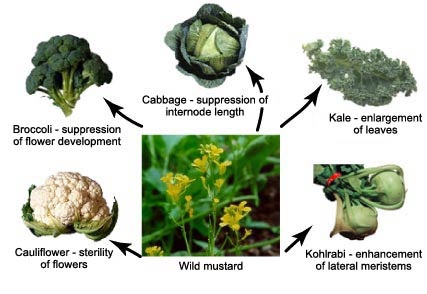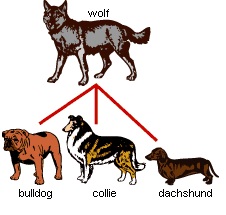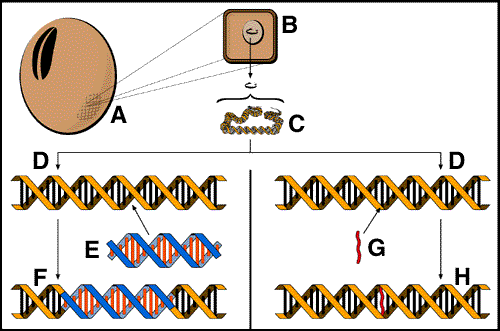READ: Artificial Selection
| Site: | Mountain Heights Academy OER |
| Course: | Biology Q3 |
| Book: | READ: Artificial Selection |
| Printed by: | Guest user |
| Date: | Saturday, 26 July 2025, 2:08 PM |
Artificial Selection vs. Natural Selection
Natural selection, as defined by Charles Darwin in the 19th century, is the process by which favorable traits for survival are passed from parent to offspring while unfavorable traits become less common in a population through time. Artificial selection involves the intentional selection of two individuals with desired traits for breeding to try to continue a family line with the desired trait. Humans have been selectively breeding plants and animals for thousands of years. The domestication of crops by native peoples may have occurred unintentionally around 8000 BC. The first domestication of animals may have been the mutualistic relationship that formed between ancient humans and the wolf about 12,000 years ago. Every domesticated breed of animal and every crop grown has been the result of selective breeding. Three examples of selective breeding are presented here. The first involves a plant, the second an animal, and the third explains how genetic engineering is the application of modern selective breeding.
Artificial Selection: Wild Mustard
Farmers have been selecting plants with desired traits long before Darwin’s proposal of natural selection. Farmers would only plant seeds from plants with specific traits. This resulted in the evolution of a variety of farm stocks. An example of artificial selection by farmers is apparent in the cultivation of wild mustard. Broccoli, cabbage, kale, cauliflower, and kohlrabi are all derived from wild mustard. As shown in Figure 1, broccoli was derived by selecting plants with reduced flowers. Over time, the suppression of flower development resulted in broccoli. The suppression of internode length (distance between branches) resulted in cabbage. When plants were selected for having larger leaves, kale was produced.

Artificial Selection: Dogs
The domestication of dogs is an example of selective breeding in animals. All domesticated dogs are the same species (Canis familiaris) but exhibit incredible variation from the tiny Chihuahua to the enormous St. Bernard, from the hairless Chinese Crested Terrier to the long haired English Sheepdog, and from the intelligent Border Collies to the challenged Irish Setters. Recent mitochondrial DNA analysis suggests that wolves split into two lines about 100,000 years ago. One line was the wolf ancestors which led to modern dogs. Domestication of these “wolf” dogs occurred about 15,000 years ago. The relationship of humans with dogs was probably accidental. About this time, it is believed that humans were giving up their nomadic lifestyles and staying at semi-permanent campsites. Wolf-dogs probably started hanging around these campsites scavenging food. Over time, social dogs integrated into human society. Humans then started selecting for more sociable dogs and dogs eventually became “man’s best friend.” Currently, there are up to 800 breeds of dogs recognized by various kennel clubs. All of these breeds originated from the same wolf-dog ancestor. Humans have routinely chosen the parent dogs for breeding because of the traits that they possessed. It was well known that the puppies had a good chance to be born with the desired trait. The puppies that did not possess the desired traits were not bred in the next generation. These breeding techniques were being practiced before the concept of the gene was understood.
Gregor Mendel and others have since explained how the existence of different forms of a gene can produce puppies with unexpected trait combinations. An example of selective breeding in dogs is one of the smallest breeds, Daschunds. In this case, the traits that were selected for were small size and short legs. After many generations, a dog breed capable of following small prey like foxes, badgers, and rabbits into burrows and flushing them out into the open for hunters was produced. The Great Dane is another result of selective breeding. These dogs were created by selecting for their large, heavy size. They were used for hunting, protection, and fighting. Dog breeds were created by selecting traits that would help humans hunt, work herds, protect property, be status symbols, to race, and to be companions.

Artifical Selection: Genetic Manipulation
While selective breeding continues in plants and animals by farmers and breeders, modern selective breeding techniques involve modifying the organism’s genome (DNA). A genetically modified organism (GMO) has a gene for a desired trait manually inserted into its genome. The magnitude of genetic change in genetically modified organisms is very different than its natural variety. The figure below illustrates how a natural genetic change is different in method and magnitude of genetic change. Plants and seeds (A) consist of many cells (B). Chromosomes in the cell (C) contain DNA molecules (D) that store genetic information. Millions of individual nucleotides make up the DNA information in a single cell. With GMOs, new genes are introduced into the cell (E) that could come from any living thing. This gene will contain the information to control a desired trait. The transgene inserts into the plant's chromosome (F) and becomes a permanent addition to the genetic information in the plant. With non-GMO crops, changes as minor as a single nucleotide change (G) in an existing gene create a new version of the gene (H) that controls a new trait in the plant. These changes can occur from natural mistakes in DNA replication or be induced by chemical treatments.

Currently, this technique is used commercially in plants and only experimentally in animals. This technique is very controversial and cutting edge at the same time. Supporters say that genetically modified foods could end world hunger while critics say the risks are still unknown and warns of “super pests” (genetic changes resulting in unwanted traits). The most common products derived from genetically modified crops are soybeans, corn, canola oil, cotton seed oil, and wheat. Current estimates say that 60% of processed food contains genetically modified ingredients . Genetic modification has resulted in rice with an inserted vitamin A gene. This rice was created to reduce blindness in poor countries that suffer from vitamin A deficiency. A variety of GMO fruits and vegetables have inserted genes to slow decomposition. Thus, increasing shelf life and reducing financial loss due to rotting fruit. The future of GMO may result in fruit with vaccines for childhood diseases, plants more resistant to drought and frost (lengthening the growing seasons), or potatoes that absorb less fat when fried. The products “invented” using this technology may be unlimited. The future of GMOs may also involve livestock. The Food and Drug Administrations recently has determined that meat and milk from cow, pig, and goat clones are safe to include in the food supply. The first approved genetically modified animal for US consumer markets may be the Aqua Bounty salmon. This salmon variety has a growth-hormone gene inserted from the Chinook salmon. The modified Aqua Bounty salmon reaches market weight in about 18 months instead of 30.
Critics are rightfully concerned about the formation of super weeds, new diseases, and other unanticipated result of genetic manipulation. Critics are especially concerned about this technique being applied to animals, including humans, as the result may be cruel to the resulting individual. The worst case scenario that critics warn about is that science may create a new organism that spawns a fatal epidemic.